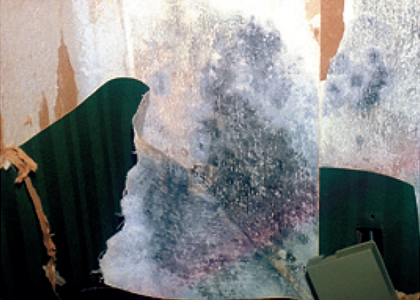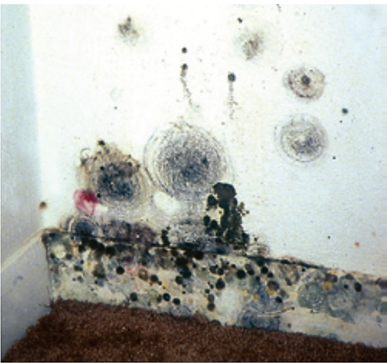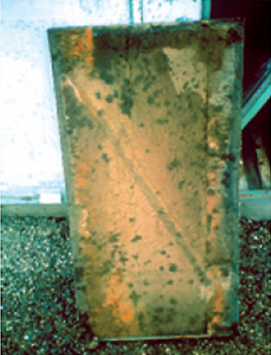Emergencies, including gas smells, smoke or unusual strong odors should be reported to Public Safety - call 911 from a campus phone or (301) 405-3333 from any phone, or text #3333.
For other IAQ issues, please select the Indoor Air Quality page.
The health and safety of University of Maryland students, faculty, staff and visitors are the most important aspects of our operations and administration. The Departments of Facilities Management, Resident Life, Residential Facilities, and Environmental Safety, Sustainability and Risk continually monitor and address concerns regarding mold growth across campus. Your contributions to these efforts are essential.
Molds are fungi that are found in nearly all locations – indoors and outdoors. They can grow most anywhere, as long as optimal moisture, oxygen, temperatures, and food sources exist. When we all understand how to identify, report and respond to the presence of mold and conditions conducive to mold growth, we minimize the impact that mold can have on the UMD community.
Below are accredited and industry accepted informational and guidance resources
regarding mold.
- OSHA mold resources
- CDC mold resources
- EPA mold resources
- EPA mold resources for environmental and public health professionals
- NIOSH mold guidance
- American Industrial Hygiene Association (AIHA) Mold Resource Center
- American Society of Heating, Refrigerating and Air-Conditioning Engineers (ASHRAE) Position Document on Limiting Mold and Dampness in Buildings
Please visit the Mold Awareness presentation to increase your understanding of mold and the associated safety and health aspects.
In addition, the following will enable you to know how to recognize mold-related problems, and to understand the program that UMD has for controlling these conditions. You may Report a Concern about Mold that you observe based on the information included below.
What causes mold to grow and spread?
Mold enters buildings through open windows and doors, heating and air conditioning systems, and when attached to clothing, shoes, and on pets. Mold is not usually a problem, unless it drops on places with excessive moisture and begins growing on surfaces.
Mold can grow almost anywhere, as long as optimal temperatures, moisture, oxygen, and food sources, such as organic matter are present. Mold grows best in warm, damp, humid conditions such as bathrooms, kitchens, and basements. It reproduces through the production of tiny reproductive cells called spores. Mold spores are always present in both the indoor and outdoor environment., and can remain viable under harsh environmental conditions. Buildings provide food sources (e.g., wood, gypsum and paper) for mold to grow
Some molds have spores that are easily disturbed and settle repeatedly with each disturbance. Other molds have sticky spores that will cling to surfaces and are dislodged by brushing against them or by other direct contact. Spores may remain able to grow for years after they are produced. In addition, whether or not the spores are alive, the allergens in and on them may remain allergenic for years.
How can I tell if I have a mold problem?
Any part of your area that gets wet has potential to be moldy. Check for:
- Leaks. If water is trapped inside your walls or under your carpet, molds may grow there, although they can't always be seen. See if your walls or rugs have light stains or a strong musty smell.
- Water damage around your windows in bathrooms, kitchen areas. Moist air can change to water on these cooler surfaces and cause molds to grow there.
- Mold on walls, ceilings, floors, carpets, or books. Appearance of materials described above or in the pictures below indicate mold presence.
The pictures below show how mold can appear in indoor environments:



Are there any state or national regulations regarding mold?
There are no federal or state regulations directly governing the presence of mold or mold spores in buildings. There are also no health standards from the Centers for Disease Control and Prevention (CDC) or public health departments for concentrations of mold spores in the indoor air. Professionals agree that the presence of visible mold on indoor building materials is an unacceptable condition, and should be remediated.
What steps can I take to help prevent mold growth?
The key to controlling mold growth on materials in the indoor environment is moisture control. This includes maintaining moderate relative humidity levels indoors, and responding promptly to water intrusion. Prompt action is vital to prohibit mold growth. If wet or damp materials are dried within 48 hours after a leak or spill happens, in most cases the mold will not grow.
Here are some simple tips you can follow to help prevent mold growth:
- Keep windows closed, particularly during periods of high humidity and rain. Uncontrolled moisture and environmental particulates can enter buildings through open windows.
- If you observe flooding or water intrusion in your building, or if your air is stagnant and/or humid, report these conditions as soon as possible for response from building personnel.
- Keep furniture and storage containers at least 12 inches from the fan coil unit (air conditioner/heater). When furniture is placed directly in front of the fan coil unit, it blocks the air flow into and out of the unit.
- Keep bathroom kitchen areas, showers, tubs clean.
- Avoid leaving wet materials on furniture or carpeting.
How does mold affect people?
Some people have no health effects from mold. People who are sensitive to mold may experience allergy-like symptoms (nasal stuffiness, eye irritation) and/or skin irritation. Depending on a person’s sensitivity, these reactions may be more or less severe. The presence of mold may also exacerbate asthma. More severe symptoms of mold exposure may include wheezing or shortness of breath. During the time of year when there is an increase in cold and flu symptoms, it can be hard to distinguish these symptoms from those caused by mold. Though there is no test for mold exposure, if you are concerned or are feeling unwell, you should consider consulting your healthcare provider or the University Health Center.
If you suffer from a weakened immune system (immunocompromised), mold damage can be even more harmful to your health. Although many people experience only mild-to-moderate effects, when your immune system is already weak due to a preexisting medical condition, you may also be more susceptible to developing a stronger reaction to mold exposure. The CDC provides guidance on mold exposure risks for immunocompromised individuals at https://www.cdc.gov/mold/306718-A_FS_MoldInfectionsPostHurricaneandFlood-H.pdf .
Should air samples be obtained for mold in my area of concern?
Mold is present in the indoor and outdoor air and on surfaces all around us each day. It requires moisture and a food source to colonize materials. The University does not conduct air sampling for mold and instead follows federal agency guidance:
From the Centers Disease Control and Prevention (CDC):
"Standards for judging what is an acceptable, tolerable, or normal quantity of mold have not been established." "Generally it is not necessary to identify the species of mold growth in a residence, and CDC does not recommend routine sampling for molds.
Current evidence indicates that allergies are the type of diseases most often associated with molds. Since the susceptibility of individuals vary greatly either because of the amount or type of mold, sampling and culturing are not reliable in determining your health risk... therefore, no matter what time of mold is present, you should arrange for its removal."
From the U.S. Environmental Protection Agency (EPA):
“In most cases, if visible mold growth is present, sampling is unnecessary. Since no EPA or other federal limits have been set for mold or mold spores, sampling cannot be used to check a building's compliance with federal mold standards.”
Should I perform any sampling using home test kits?
The U.S. Military Public Health Center and Consumer Reports have provided detailed reports recommending against the use of home mold test kits. These kits do not provide accurate data nor identify sources where microbial growth can occur.
Petri dishes with agar encourage mold growth. This is not an accurate assessment of the likelihood of future mold growth or the presence of mold growth. Since mold is found everywhere in the indoor and outdoor environment, it is expected a Petri dish will grow mold.
When I suspect mold growth, what should I do?
The best course of action if you suspect microbial growth is to submit a work request to departments that have been designated and trained to respond to mold concerns:
- Employees: Contact Facilities Management Customer Response Center at (301) 405-2222
- Students: Contact Residential Facilities Work Requests at (301) 404-WORK (9675)
- Dining Services Work Requests (301) 314-8086
Trained personnel will promptly respond to inspect the space to identify any visual growth or sources of water that should not be present. If any type of old growth is found, it will be cleaned or removed by qualified personnel.
Should I purchase a portable air cleaner and dehumidifier?
Professional grade dehumidifiers have been placed in impacted buildings around campus. If you choose to use your own dehumidifier, you will need to maintain it properly. This includes regular cleaning and emptying of the reservoir. If you would like to purchase a portable air cleaner for your residence, please refer to this EPA Publication: Guide to Air Cleaners in the Home
Is it safe for me to stay in my area that currently has mold?
According to federal health and safety agencies, mold growth is commonly found in both indoor and outdoor environments. Some people are sensitive to mold and may experience short-term reactions in the presence of mold growth. Symptoms associated with mold exposure are not unique and cannot be readily distinguished from symptoms caused by other medical conditions, such as the common cold or seasonal environmental allergies. Since some individuals may have more intense reactions, those with medical conditions or who experience symptoms should consult with a healthcare professional regarding their risk to mold exposure.
What do I do if I experience symptoms?
If you experience symptoms that you suspect are linked to mold exposure, you should use the mold concern submittal to receive consultation on the suspect mold growth in your area(s). In conjunction with this, you should also visit the University Health Center or your doctor to determine the likelihood that what you are experiencing may be related to mold.
Questions related to Residential Facilities
For answers to frequently asked questions related to general mold information, please visit UMD's Resident Life webpage.
